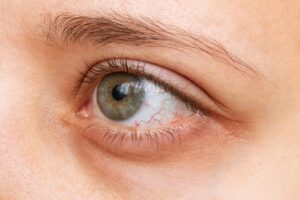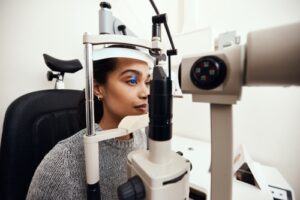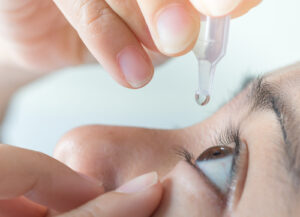Dry eye syndrome can cause a range of symptoms, from irritation and itchiness to redness and blurry vision. Some people may experience these symptoms chronically, making every season a challenge.
However, some people may experience a worsening of their symptoms only during certain times of the year. Keep reading to learn if there is a certain time of the year when dry eye is worse!
What is Dry Eye Syndrome?
Before we dive into the effect that different seasons have on your dry eye symptoms, let’s first talk about what dry eye syndrome actually is. Dry eye syndrome is a very common eye condition that occurs when the cornea lacks proper lubrication.

The cornea is the transparent dome-like structure that acts as a window at the front of your eye. Dry eye syndrome can occur for various reasons, and many factors can contribute to or exacerbate your symptoms.
Often, dry eye syndrome is due to either an issue with tear production or a lack of quality tears. If your cornea is very dry, you will likely experience various symptoms, including irritation.
As mentioned before, dry eye can be a chronic eye condition requiring professional treatment. If left untreated, dry eye can affect your vision and even cause permanent damage to your cornea.
At Blaine Eye Clinic, you’ll find that our talented team is experienced in diagnosing and treating dry eye syndrome and can help improve your symptoms.
What Are the Most Common Symptoms of Dry Eye Syndrome?
Dry eyes can cause different symptoms in different people. It can also cause different symptoms depending on the root cause of the condition.
These are some of the most common symptoms of dry eye:
- An itching, burning, or scratching sensation
- Redness
- Tearing
- Crusting around eyes
- Increased light sensitivity
Another common symptom of dry eye can be blurry vision. The compounding of all of these symptoms can make dry eyes very difficult to live with!
If you are noticing any of these symptoms, it’s best to visit your eye doctor at Blaine Eye Clinic for an accurate diagnosis. Once your eye doctor is able to determine if your symptoms are caused by dry eye, they can recommend a treatment plan to help your eyes feel better!
What Seasons Typically Worsen Dry Eye Symptoms?
Now that you have learned the basics of dry eye, you may wonder if it’s possible to experience a worsening of dry eye symptoms during certain times of the year. Since the environment can have an impact on how well your eyes are lubricated, you may notice that your dry eye symptoms are worse during seasons when the air is drier.
Thanks to the cold, dry air that is common during the winter months, most people tend to notice a worsening in symptoms like irritation, dryness, and tearing during this time of year. Most areas that experience cold winter weather will also experience low moisture levels in the air during the winter.

Furthermore, the winter months can be windier as well, which can also cause your eyes to be more dry than usual. The outside air is not the only thing that’s dry, though!
Indoor heating systems also tend to cause the air inside to be dry as well. When the air in your environment is dry, it can make it challenging for your eyes to keep up with the lubrication of your cornea.
To combat the dry air inside your home, your eye doctor may recommend using humidifiers. It may also be a good idea to point air vents away from your face when in the car to avoid having a direct stream of dry air into your eyes.
The cold air is here in Minnesota, so if you’re experiencing a worsening of your dry eye symptoms, schedule an appointment with your eye doctor at Blaine Eye Clinic to learn more about how to combat the dry air.
How Do I Know If I Have Allergies or Dry Eye Syndrome?
Although the dry winter air can cause your dry eye to worsen, if you have chronic dry eye, you may also experience dry eye symptoms at other times of the year, depending on the weather and your environment. However, dry eye symptoms that occur during allergy season are often confused with allergy symptoms.

It is challenging to determine which condition is causing your symptoms because the symptoms for both are typically very similar. The best way to tell whether or not your symptoms are caused by dry eye syndrome or allergies is to visit your eye doctor for an eye exam.
Make sure to tell your eye doctor about the specific symptoms you are experiencing, when they appeared and if anything seems to improve them. Your eye doctor will thoroughly evaluate your eyes, including a close look at the cornea and other structures of your eyes, to determine what is causing your symptoms.
At Blaine Eye Clinic, our eye doctors use some of the most advanced technology to help diagnose dry eye and determine the root cause in each specific case. This includes TearLab and InflammaDry.
Both of these tools help measure different factors that can help your eye doctor determine the best way to treat your dry eye. Since dry eye syndrome is a chronic eye condition, it is important to determine what is causing your symptoms so that you can receive treatment and prevent the condition from worsening.
How Do Eye Doctors Treat Dry Eye?

Once you visit your eye doctor at Blaine Eye Clinic to evaluate your symptoms, they may recommend making a few lifestyle changes, like drinking more water, eating a balanced diet, and increasing your use of artificial lubricating drops.
In some cases, you may need further treatment to help restore the health of your cornea and reduce your symptoms. The eye doctors at Blaine Eye Clinic offer several effective treatments for dry eye!
For example, the Lumenis OptiLight is a state-of-the-art intense pulsed light (IPL) therapy applied to the skin under your eyes. This treatment can help improve dry eye symptoms by supporting the tear-producing glands in your eyes and helping to prevent the rapid evaporation of tears from your cornea.
You can trust that your eye doctor at Blaine Eye Clinic will create a plan to help you enjoy long-lasting relief from dry eye, at any time of the year.
Are you experiencing symptoms of dry eye? Schedule an appointment at Blaine Eye Clinic in Blaine, MN, today!





